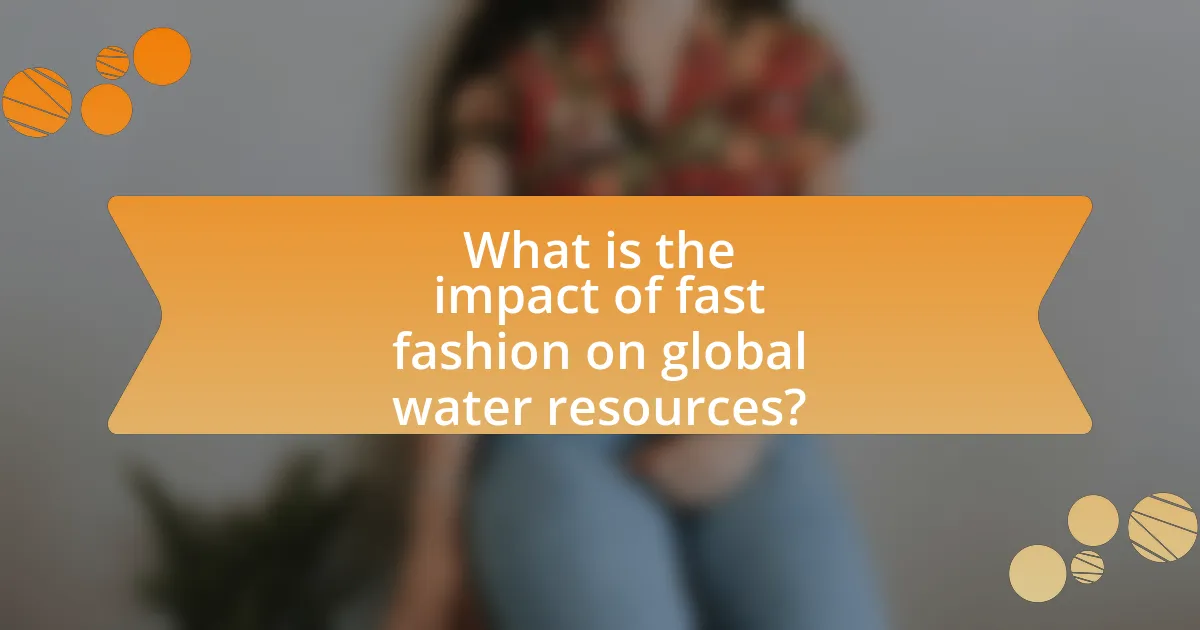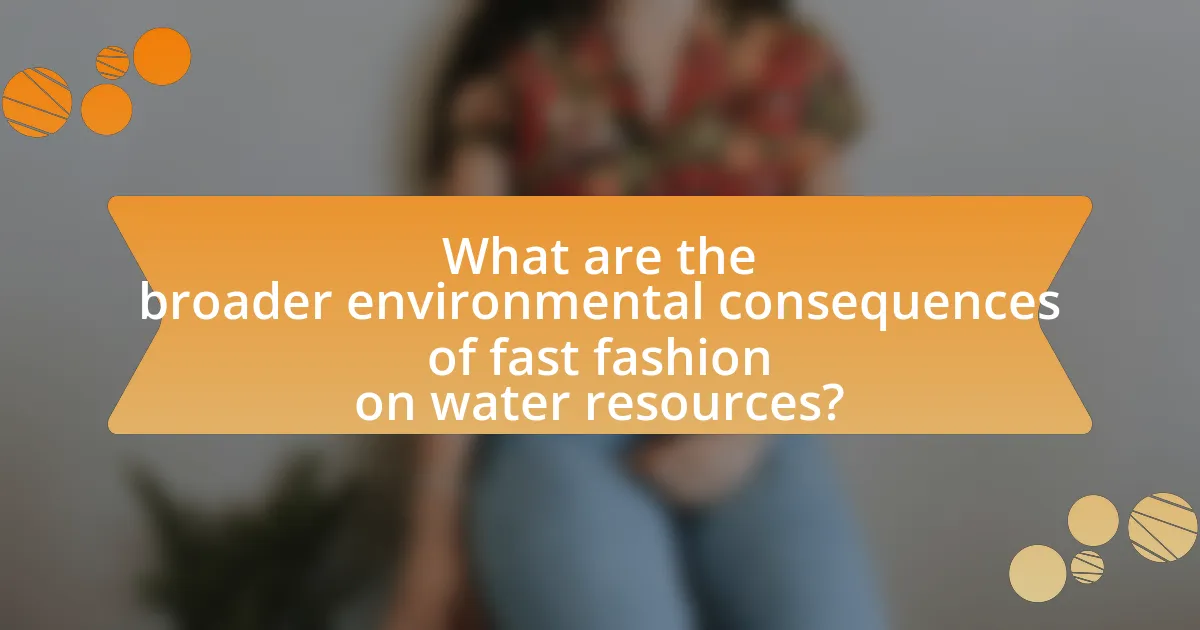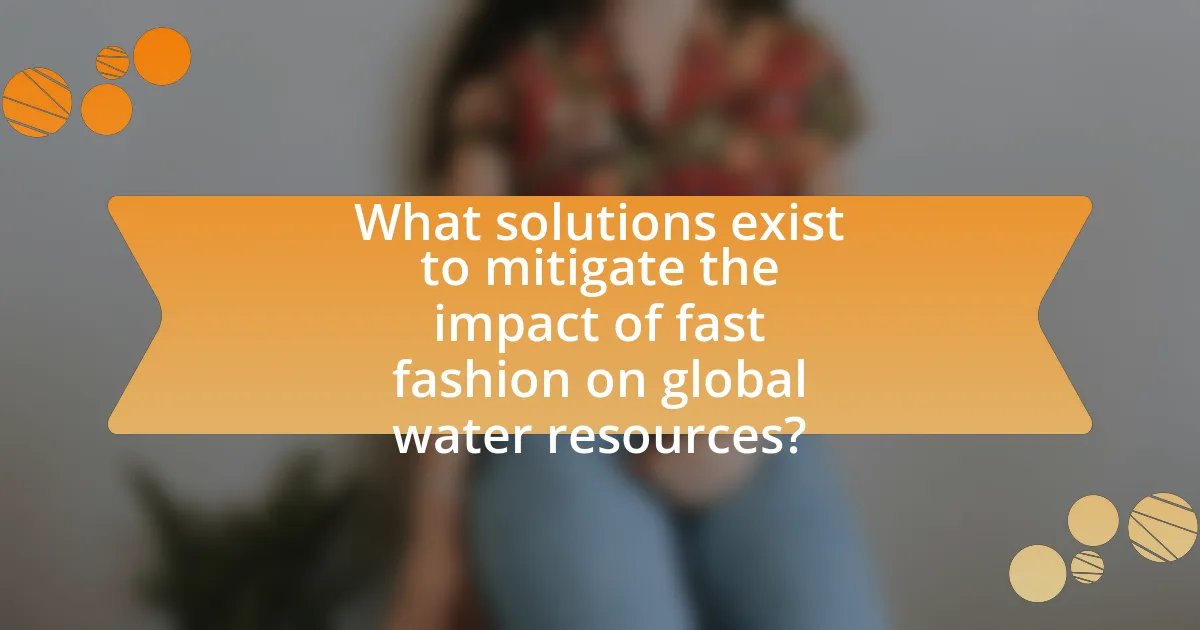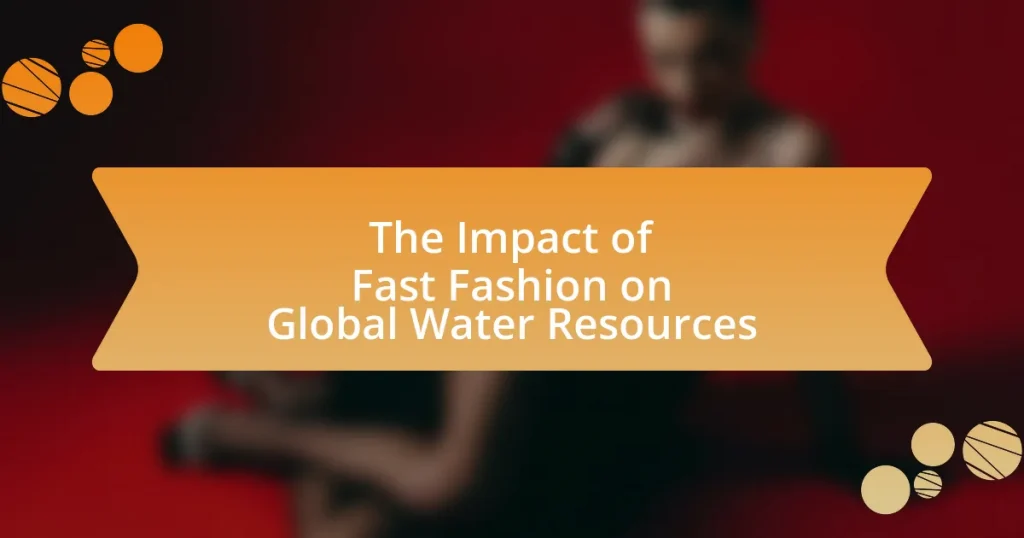The article examines the significant impact of fast fashion on global water resources, highlighting excessive water consumption and pollution associated with the industry. It details that the production of a single cotton t-shirt requires approximately 2,700 liters of water and that the fashion sector is responsible for 20% of global wastewater. The article discusses the main pollutants linked to fast fashion, including synthetic dyes and heavy metals, and their detrimental effects on aquatic ecosystems and local communities. Additionally, it explores the implications of water scarcity in production regions, the role of governments in regulating water use, and potential solutions for mitigating the environmental impact of fast fashion on water resources.

What is the impact of fast fashion on global water resources?
Fast fashion significantly depletes global water resources through excessive water consumption and pollution. The production of a single cotton t-shirt requires approximately 2,700 liters of water, which is enough for one person to drink for two and a half years. Additionally, the fast fashion industry contributes to water pollution, with textile dyeing processes releasing toxic chemicals into waterways, affecting both ecosystems and human health. According to the United Nations, the fashion industry is responsible for 20% of global wastewater, highlighting its detrimental impact on water quality and availability.
How does fast fashion contribute to water pollution?
Fast fashion contributes to water pollution primarily through the excessive use of water in textile production and the discharge of untreated wastewater. The fashion industry is responsible for approximately 20% of global wastewater, as it requires vast amounts of water for dyeing and finishing processes. Additionally, many fast fashion brands often release toxic chemicals, such as dyes and heavy metals, into water bodies without proper treatment, leading to contamination of local water sources. This pollution not only affects aquatic ecosystems but also poses health risks to communities relying on these water sources for drinking and agriculture.
What are the main pollutants associated with fast fashion production?
The main pollutants associated with fast fashion production include synthetic dyes, microplastics, and heavy metals. Synthetic dyes, commonly used in textile production, can contaminate water sources, with studies indicating that up to 20% of global water pollution comes from dyeing processes. Microplastics, shed from polyester and other synthetic fabrics during washing, contribute significantly to ocean pollution, with an estimated 1.7 million tons entering marine environments annually. Heavy metals, such as lead and cadmium, often found in dyes and finishing agents, pose serious environmental and health risks, as they can leach into water systems and accumulate in aquatic life.
How do these pollutants affect aquatic ecosystems?
Pollutants from fast fashion significantly harm aquatic ecosystems by introducing toxic substances that disrupt the health of water bodies. These pollutants, including dyes, microplastics, and heavy metals, can lead to decreased biodiversity, as many aquatic organisms are sensitive to chemical changes in their environment. For instance, studies have shown that textile dyes can be lethal to fish and invertebrates, reducing populations and altering community structures. Additionally, microplastics can accumulate in the food chain, affecting not only aquatic life but also the animals and humans that consume them. Research indicates that heavy metals from textile production can contaminate sediments and water, leading to long-term ecological damage and bioaccumulation in aquatic species.
What is the water consumption associated with fast fashion?
Fast fashion is associated with significant water consumption, estimated at around 2,700 liters of water to produce a single cotton t-shirt. This high water usage stems from the extensive agricultural practices required for cotton cultivation, which is a primary material in fast fashion. Additionally, the dyeing and finishing processes in garment production further contribute to water consumption, with the industry collectively using approximately 93 billion cubic meters of water annually. This staggering figure highlights the environmental impact of fast fashion on global water resources, exacerbating water scarcity in many regions.
How much water is used in the production of a single garment?
The production of a single garment typically uses about 2,700 liters of water. This figure is based on the water required for various stages of garment production, including cotton cultivation, dyeing, and finishing processes. According to the World Wildlife Fund, the fashion industry is responsible for significant water consumption, with cotton alone accounting for a large portion of this usage.
What are the implications of high water usage in fast fashion?
High water usage in fast fashion leads to significant environmental degradation and resource depletion. The fashion industry is responsible for consuming approximately 93 billion cubic meters of water annually, which contributes to water scarcity in many regions. This excessive water consumption not only strains local water supplies but also results in pollution from dyeing and finishing processes, contaminating freshwater sources. Furthermore, the high demand for water in cotton production, a primary material for fast fashion, exacerbates soil degradation and reduces agricultural productivity. These implications highlight the urgent need for sustainable practices within the fashion industry to mitigate its impact on global water resources.
Why is water scarcity a concern in fast fashion production regions?
Water scarcity is a concern in fast fashion production regions because these areas often rely on significant water resources for textile manufacturing, dyeing, and finishing processes. The fast fashion industry is characterized by rapid production cycles and high demand for cheap clothing, which exacerbates water consumption. For instance, it takes approximately 2,700 liters of water to produce a single cotton t-shirt, highlighting the industry’s substantial water footprint. Additionally, many fast fashion production regions are located in water-stressed areas, where the over-extraction of water for textile production can lead to depletion of local water supplies, negatively impacting communities and ecosystems.
What regions are most affected by water scarcity due to fast fashion?
The regions most affected by water scarcity due to fast fashion include South Asia, particularly India and Bangladesh, as well as parts of Central Asia and the Middle East. In India, the textile industry consumes approximately 1.5 trillion liters of water annually, exacerbating water shortages in areas like Rajasthan and Gujarat. Bangladesh faces similar challenges, with the garment sector using around 1.5 billion cubic meters of water each year, contributing to severe water stress in regions like Dhaka. Central Asia, especially Uzbekistan, is heavily impacted due to cotton production, which is water-intensive and has led to the depletion of the Aral Sea. The Middle East, particularly countries like Jordan and Lebanon, also experiences water scarcity linked to the demands of fast fashion, as the industry requires significant water resources for dyeing and finishing processes.
How does fast fashion exacerbate existing water scarcity issues?
Fast fashion exacerbates existing water scarcity issues by significantly increasing water consumption and pollution in textile production. The fast fashion industry requires vast amounts of water for processes such as dyeing and finishing fabrics, with estimates suggesting that producing a single cotton t-shirt can consume up to 2,700 liters of water. This high demand for water strains local water supplies, particularly in regions already facing water scarcity. Additionally, the discharge of untreated wastewater from textile factories contaminates freshwater sources, further diminishing the availability of clean water for communities. According to the United Nations, the fashion industry is responsible for 20% of global wastewater, highlighting its detrimental impact on water resources.

What are the broader environmental consequences of fast fashion on water resources?
Fast fashion significantly depletes water resources, leading to severe environmental consequences. The industry consumes approximately 93 billion cubic meters of water annually, which is enough to meet the needs of five million people. This excessive water usage contributes to the depletion of freshwater sources, particularly in regions already facing water scarcity. Additionally, the production processes often involve toxic chemicals that contaminate local water supplies, harming ecosystems and human health. For instance, the dyeing process in textile manufacturing can pollute rivers, affecting aquatic life and communities reliant on these water sources.
How does fast fashion impact local communities’ access to clean water?
Fast fashion significantly impacts local communities’ access to clean water by polluting water sources and depleting freshwater resources. The production processes in fast fashion often involve the use of toxic chemicals, which are discharged into nearby rivers and lakes, contaminating drinking water supplies. For instance, a report by the World Bank indicates that textile dyeing is responsible for 20% of global water pollution, affecting communities reliant on these water sources for their daily needs. Additionally, the high water consumption required for cotton farming and garment production exacerbates water scarcity in regions already facing water stress, further limiting access to clean water for local populations.
What are the social implications of water pollution from fast fashion?
Water pollution from fast fashion has significant social implications, primarily affecting communities reliant on contaminated water sources. The textile industry discharges toxic chemicals into rivers and lakes, leading to health issues such as skin diseases and respiratory problems among local populations. For instance, a study by the World Bank indicates that textile dyeing and finishing processes contribute to 20% of global industrial water pollution, impacting the health and livelihoods of millions, particularly in developing countries where regulations are often lax. Additionally, the degradation of water quality can lead to reduced agricultural productivity, exacerbating food insecurity and economic instability in affected regions.
How do communities adapt to water scarcity caused by fast fashion?
Communities adapt to water scarcity caused by fast fashion by implementing water conservation practices, utilizing alternative water sources, and advocating for sustainable fashion policies. For instance, in regions heavily impacted by textile production, such as parts of India, local farmers have adopted rainwater harvesting techniques to supplement their water supply. Additionally, communities often engage in awareness campaigns to educate consumers about the environmental impacts of fast fashion, thereby promoting responsible consumption. Research indicates that in areas like the Aral Sea basin, where water resources have been severely depleted due to cotton production for fast fashion, local initiatives have focused on crop diversification and sustainable agricultural practices to reduce water dependency. These adaptations demonstrate resilience and a proactive approach to mitigating the effects of water scarcity linked to the fast fashion industry.
What role do governments play in regulating water use in the fast fashion industry?
Governments play a crucial role in regulating water use in the fast fashion industry by implementing policies and legislation aimed at sustainable water management. These regulations often include setting limits on water extraction, enforcing wastewater treatment standards, and promoting water conservation practices among manufacturers. For instance, countries like Bangladesh have introduced laws requiring textile factories to treat wastewater before discharge, addressing the significant pollution caused by the industry. Additionally, governments may incentivize the adoption of water-efficient technologies through grants or subsidies, further encouraging sustainable practices. Such regulatory frameworks are essential for mitigating the environmental impact of fast fashion on global water resources.
What policies exist to mitigate the impact of fast fashion on water resources?
Policies to mitigate the impact of fast fashion on water resources include regulations on water usage, wastewater treatment requirements, and sustainable sourcing initiatives. For instance, the European Union’s Water Framework Directive mandates member states to achieve good water quality and manage water resources sustainably, which indirectly affects the textile industry by enforcing stricter regulations on water pollution. Additionally, countries like Bangladesh have implemented the “Sustainable Apparel and Textile (SAT) Program,” which promotes water-efficient practices among garment manufacturers. These policies aim to reduce water consumption and improve wastewater management, thereby addressing the environmental challenges posed by fast fashion.
How effective are these policies in protecting water resources?
The effectiveness of policies aimed at protecting water resources in the context of fast fashion is limited. Research indicates that many regulations fail to address the specific pollution and water usage issues associated with the fast fashion industry. For instance, a study by the Ellen MacArthur Foundation highlights that the fashion sector is responsible for 20% of global wastewater, yet existing policies often lack stringent enforcement mechanisms and comprehensive frameworks to mitigate this impact. Furthermore, the lack of accountability for water-intensive production processes allows companies to continue practices that deplete and contaminate water resources.

What solutions exist to mitigate the impact of fast fashion on global water resources?
Solutions to mitigate the impact of fast fashion on global water resources include adopting sustainable production practices, implementing water-efficient technologies, and promoting circular fashion. Sustainable production practices, such as using organic materials and reducing chemical usage, can significantly decrease water pollution and consumption. For instance, the use of water-efficient dyeing technologies can reduce water usage by up to 90% compared to traditional methods. Additionally, promoting circular fashion through recycling and upcycling can extend the lifecycle of garments, thereby reducing the demand for new production and its associated water usage. These strategies collectively contribute to conserving water resources and minimizing the environmental footprint of the fashion industry.
How can consumers reduce their water footprint related to fast fashion?
Consumers can reduce their water footprint related to fast fashion by choosing sustainable clothing options and minimizing their consumption. Sustainable brands often use less water in their production processes; for example, organic cotton requires 91% less water than conventional cotton. Additionally, consumers can extend the life of their garments through proper care, such as washing in cold water and air drying, which conserves water and energy. By opting for second-hand clothing, consumers also contribute to reducing the demand for new production, further decreasing water usage associated with fast fashion.
What practices can consumers adopt to support sustainable fashion?
Consumers can adopt several practices to support sustainable fashion, including purchasing from eco-friendly brands, choosing second-hand clothing, and reducing overall consumption. By selecting brands that prioritize sustainable materials and ethical production methods, consumers can directly influence the fashion industry to adopt more environmentally friendly practices. Buying second-hand clothing extends the lifecycle of garments, reducing waste and the demand for new production, which is particularly important given that the fashion industry is responsible for significant water pollution and resource depletion. Additionally, reducing overall consumption by embracing minimalism or capsule wardrobes can help mitigate the environmental impact associated with fast fashion, which contributes to the depletion of global water resources through excessive water usage in textile production.
How does choosing sustainable brands impact water resources?
Choosing sustainable brands positively impacts water resources by reducing water consumption and pollution associated with production processes. Sustainable brands often implement practices that minimize water usage, such as using organic materials that require less irrigation and adopting technologies that recycle water during manufacturing. For instance, the sustainable fashion brand Patagonia has reported that its processes use 84% less water compared to conventional methods. Additionally, these brands typically avoid harmful chemicals that can contaminate water supplies, thereby protecting aquatic ecosystems. By supporting sustainable brands, consumers contribute to a decrease in the overall water footprint of the fashion industry, which is crucial given that the textile sector is responsible for significant water pollution and depletion globally.
What innovations are being developed to reduce water usage in the fashion industry?
Innovations being developed to reduce water usage in the fashion industry include waterless dyeing technologies, such as digital printing and air-dye methods, which significantly minimize water consumption during the dyeing process. For instance, the air-dye technique uses air instead of water to apply dye to fabrics, reducing water usage by up to 90%. Additionally, companies are adopting closed-loop systems that recycle water used in production, further decreasing overall water consumption. Research from the Ellen MacArthur Foundation highlights that implementing these technologies can lead to substantial reductions in water waste, addressing the critical issue of water scarcity linked to fast fashion.
What technologies are being implemented to clean water used in production?
Technologies being implemented to clean water used in production include advanced filtration systems, reverse osmosis, and biological treatment processes. Advanced filtration systems, such as membrane filtration, effectively remove contaminants and particulates from water, ensuring its purity for reuse in production. Reverse osmosis utilizes a semi-permeable membrane to separate impurities from water, achieving high levels of purification. Biological treatment processes, including activated sludge and bioreactors, leverage microorganisms to break down organic pollutants, further enhancing water quality. These technologies are essential in mitigating the environmental impact of fast fashion on global water resources by promoting sustainable water management practices.
How can water recycling be integrated into fast fashion manufacturing?
Water recycling can be integrated into fast fashion manufacturing by implementing closed-loop systems that treat and reuse wastewater generated during production processes. These systems can significantly reduce the demand for fresh water, as they allow manufacturers to recycle up to 90% of the water used in dyeing and finishing textiles. For instance, companies like Levi Strauss & Co. have adopted water recycling technologies that not only minimize water consumption but also lower pollution levels by treating wastewater before it is released. This approach not only conserves water resources but also aligns with sustainability goals, as evidenced by the fact that the fashion industry is responsible for approximately 20% of global wastewater.
What are the best practices for brands to minimize their water impact?
Brands can minimize their water impact by implementing water-efficient practices throughout their supply chain. This includes adopting technologies that reduce water usage in production processes, such as closed-loop systems that recycle water, and utilizing waterless dyeing techniques. For instance, brands like Levi’s have reported a 96% reduction in water usage through their Water
How can brands implement sustainable water management practices?
Brands can implement sustainable water management practices by adopting water-efficient technologies and processes in their production cycles. For instance, utilizing closed-loop systems can significantly reduce water consumption and wastewater generation. According to a report by the Ellen MacArthur Foundation, the fashion industry could save up to 1.5 trillion liters of water annually by adopting such technologies. Additionally, brands can engage in water stewardship initiatives, collaborating with local communities to protect water sources and improve water quality. Implementing these practices not only conserves water but also enhances brand reputation and compliance with environmental regulations.
What certifications or standards can guide brands in reducing water usage?
Certifications and standards that guide brands in reducing water usage include the Global Water Stewardship (GWS) standard, the Alliance for Water Stewardship (AWS) standard, and the ISO 14046 standard for water footprint assessment. The GWS standard provides a framework for organizations to manage water resources sustainably, emphasizing the importance of responsible water use. The AWS standard offers a comprehensive approach to water stewardship, focusing on balancing social, environmental, and economic needs. ISO 14046 specifically addresses the assessment of the water footprint of products, helping brands identify and mitigate their water impacts. These certifications are backed by organizations that promote sustainable practices, ensuring that brands can effectively reduce their water usage while maintaining compliance with recognized standards.



